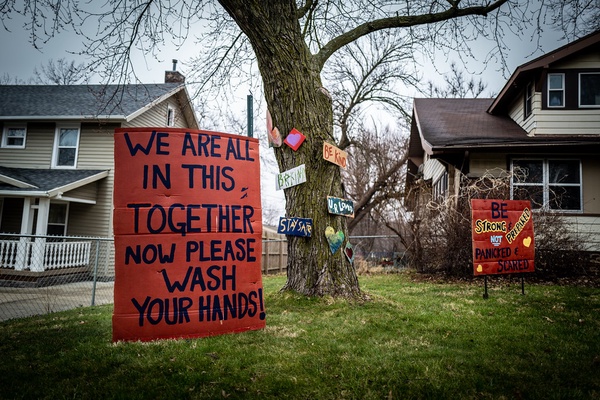Then and Now: Who Has Really Had the Advantage in a Pandemic?
Life seemed to shift in an instant with school closures, stay-at-home orders, and a nation-wide economic shutdown, as a result of the health crisis and the super-spread of COVID-19. For many Americans, this was an entirely new and nerve-wracking experience, due to the virus’s quick spread and varying symptoms, of which there seemed to be a new one each week. However, historians and scientists alike began to draw parallels between the pandemic of 2020 and that of the Spanish Influenza, which began in the spring over a century earlier. But just how similar are the two? And who has had the advantage in the face of a global pandemic?
One of the key differences between the two is the virus itself. While the Spanish Influenza was an H1N1 flu virus with avian genetic links, Covid-19 is a coronavirus. However, both viruses are likely zoonotic, which means that they are both transmitted from animals or insects, to humans.

Likewise, the symptoms of these two viruses, primarily fatigue, chills, fevers and other common influenza symptoms are similar, though, COVID-19 has a range of additional potential symptoms, including a loss of taste or smell and nausea or vomiting. While its symptoms often vary from person to person–with some infected people not experiencing any at all–a large issue when it comes to the spread of the virus is that it may even go undetected. For the most part, those infected with the flu virus, during the Spanish Influenza pandemic, would mainly have the same expected symptoms.
Another distinction between the Spanish Influenza and COVID-19 is what age group is most affected. The Spanish Influenza had a high mortality rate in young people especially those under 5, and is known for an unusually high mortality rate in healthy 20-40 year olds. COVID-19 has a higher mortality rate as age increases, and can be especially harmful to those with underlying medical conditions. Further, young people have the lowest mortality and highest recovery rate, a notable difference.
A key similarity of the viruses is the effect of the virus, in terms of race and socioeconomic status. In 1918, the world was recovering from the end of World War I and many lived in overcrowded, unhygienic areas with a lack of sanitation and access to healthcare. Due to the poor sanitation and limited medical and nutritional resources, those in poverty were likely the first to be infected and later die. In 2020, studies have shown that ethnic minority groups have been disproportionately affected by the coronavirus. In fact, Black Americans are dying at 2.4 times the rate of White Americans, while Indigenous peoples and Alaskan natives have a mortality rate that is 1.5 times that of White Americans. Additionally, those in poverty are at a higher risk of contracting the virus, due to a lack of availability to leave jobs, often as essential workers, a lack of access to health care, and additionally, are at a disadvantage because they do not have enough money to purchase essential goods.
Another area of both similarities and differences is evident in the global and domestic responses to the spread of the pandemic. For both pandemics, in the United States, public gatherings and institutions were regulated through closures. A milder version of closures and regulations occurred throughout the rest of the world for the Spanish Influenza, but when it came to COVID-19, many countries across the globe enforced strict regulations to stop the spread. While 47 states had school closures that lasted often from March until the end of the school year, school closures throughout the United States occurred but were not as common in 1918. In fact, similarly, basic preventative measures such as hand washing, disinfecting, and isolation were used, but not nearly as widespread and common as they are now. Being in quarantine was often reserved for sick patients in 1918, rather than the present 2020 quarantine, which spans multiple counties here in California and throughout other states. For example, Los Angeles County had issued a stay-at-home order to limit transmission of the virus, as early as March of 2020.
While the United States has not had a major second wave of COVID-19, it is suspected that one will occur in the fall, unless it can be prevented. The second wave of Spanish Influenza, which occurred in the fall of 1918 proved to be even more deadly to the United States, as places reopened and public gatherings became more frequent. Later, a third and final wave hit in the winter of 1918 and 1919, before the virus finally started to flatten in the summer of 1919. According to the CDC, we do not yet know if or when the 2020 pandemic will begin to cease.
A major advantage of living through the pandemic in 2020 is clear: technology. Though the screen time may contribute to headaches and restlessness–for a large majority–it allows for both education and communication from the safety of one’s own home. Families and friends can talk virtually, helping to quell feelings of loneliness and fear. Many students ended the 2019-2020 school year entirely online, and 40 counties in California began the school year online as well.
Our very own Mayfield 2020-2021 school began behind screens for the very first time. While many students were glad to be able to meet online, others stressed their concern about the screen time and lack of connection. Senior Keara Keelty ‘21 remarked that “While I’m glad to see my classmates, it’s difficult to not be able to see them in person. Especially since our school has such an amazing sense of community”. As of November, students are still not able to return to campus.
An additional benefit to our current technology is that data regarding the virus can be frequently measured, updated, and distributed to the public through statistics and graphs. The sharing of data and information has shown how the variance in how different countries have dealt with the virus, and whether their methods have been effective. However, the increased use in technology negatively impacts low-income and disadvantaged students—25% of whom do not have a computer to use for learning. Overall, technology is an asset that greatly benefits those living through the time of COVID-19.
Thus, the two health pandemics have quite a few parallels, despite being a century apart. Even with their similarities, there are also major variances, especially our modern technology and sanitation efforts, as well as the medical knowledge we have gained in the past hundred years. These differences provide us with some benefits in the face of the virus. As of August 2020, the worldwide COVID-19 death toll topped 800,000 which appears to be a small number in comparison to the daunting 50 million of the 1918 Spanish Influenza pandemic. However, the question of who really has it better remains, as the COVID-19 virus continues to spread, with a low likelihood of slowing down anytime soon, especially in the United States.

Grace is currently a senior at Mayfield Senior School and is the Editor-In-Chief of Editorials. She has been a member of the Mayfield Crier Staff since...


